Recent Articles
Popular Makes
Body Types
2020 Volkswagen Atlas Cross Sport vs. 2020 Ford Edge

2020 Volkswagen Atlas Cross Sport SE ・ Photo by Brady Holt
Most mid-size and large crossover SUVs come with three rows of seats. From a functional perspective, it only makes sense. These SUVs are big enough to fit a third row, and many families demand the functionality of seating seven or eight passengers. But when someone wants a roomy SUV without needing seven-passenger seating, the family-friendly models can feel too bulky or look too boxy. In response, more automakers are rolling out more stylish mid-size crossovers with just two rows of seats.
One of the newest such models is the all-new 2020 Volkswagen Atlas Cross Sport. To create the Cross Sport, Volkswagen took its three-row Atlas and chopped a couple inches off its height and length. The sportier-looking result is ready to take on one of the class’s established best-sellers: the 2020 Ford Edge, the third generation of a mid-size five-seater that first debuted in 2007. Let’s go over the details of these two rivals and see which mid-size two-row SUV belongs in your driveway.
Exterior Design
The standard Volkswagen Atlas is a big, boxy vehicle that looks purposeful and functional. Some buyers will love that handsomely utilitarian vibe. Others will want something that looks more ready to play. Hence the Atlas Cross Sport. Its lowered roof gives the look of a sporty hatchback on stilts, almost like a mainstream-priced BMW X6 or Mercedes-Benz GLE Coupe.
The Ford Edge is a more conventionally styled crossover. Its edges are more rounded than the VW’s, and it’s styled for on-road luxury more than off-road ruggedness, but this Ford still has a more SUV-like profile. It’s gentler, less aggressive, and more functional-looking than the lower, wider Atlas Cross Sport. Tastes will differ, so we’ll call this category a tie.
Tie
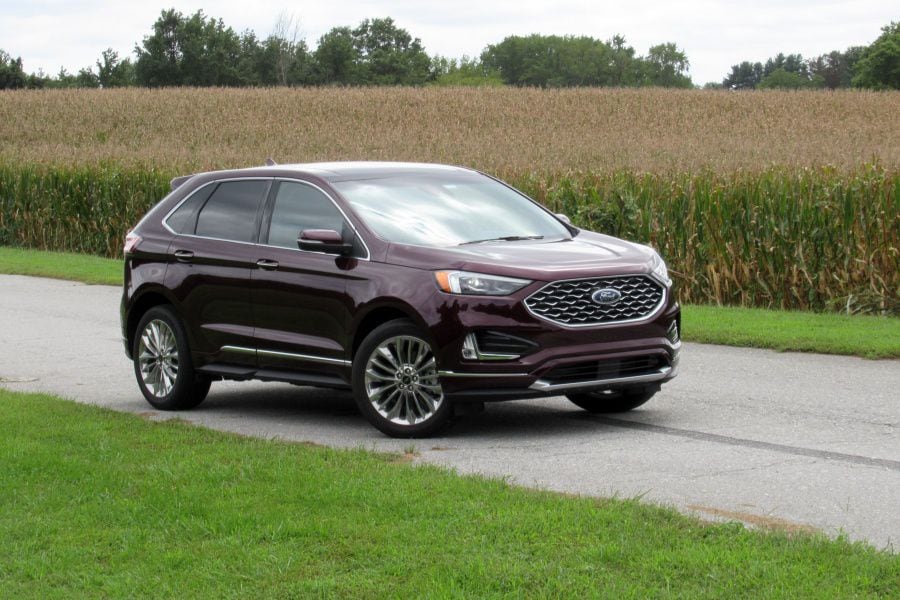
Photo by Brady Holt
Interior Design
Like most Volkswagens, the Atlas Cross Sport has a simple, almost austere dashboard design. Straight lines rule the day, and all buttons and knobs are simple. It’s at odds with the SUV’s more exuberant exterior design, and many of its plastics feel downscale.
The Edge has more curves in its interior, and some materials are richer than the VW’s. But its unconventional dashboard controls require more attention to operate, and there’s lots of empty gray plastic on the instrument panel. Neither of these interiors is a mid-size SUV standout, and we’ll once again leave the winner up to your individual taste.
Tie
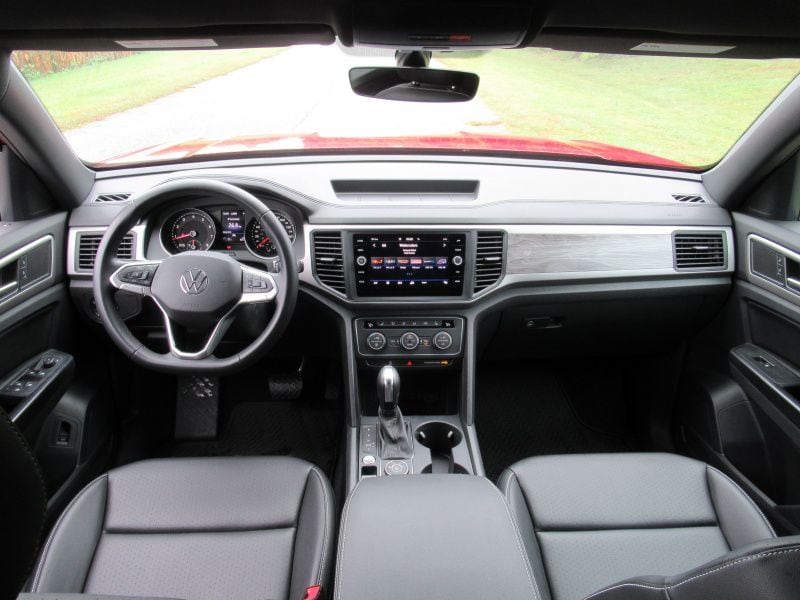
Photo by Brady Holt
Interior Comfort
The Atlas Cross Sport is much bigger than the Edge. It measures 195.5 inches long versus the Edge’s 188.8 inches, and the VW also 78.4 inches wide versus the Ford’s 75.9 inches. That’s because the Cross Sport is nearly the same size as the standard three-row Atlas, while the Edge is significantly smaller than Ford’s three-row Explorer. The result is that the Atlas Cross Sport feels more open and airier than the Edge.
That said, we’re going to award this category to the Edge. It’s also agreeably spacious, and its seats are also better-shaped and more plushly padded. The Atlas’s flatter, harder seats aren’t objectionable, but nor are they sumptuous cushions to sink into. Volkswagen does provide decent bolstering that you feel if you start to push the Atlas Cross Sport, but the Edge’s accommodations are more upscale and welcoming.
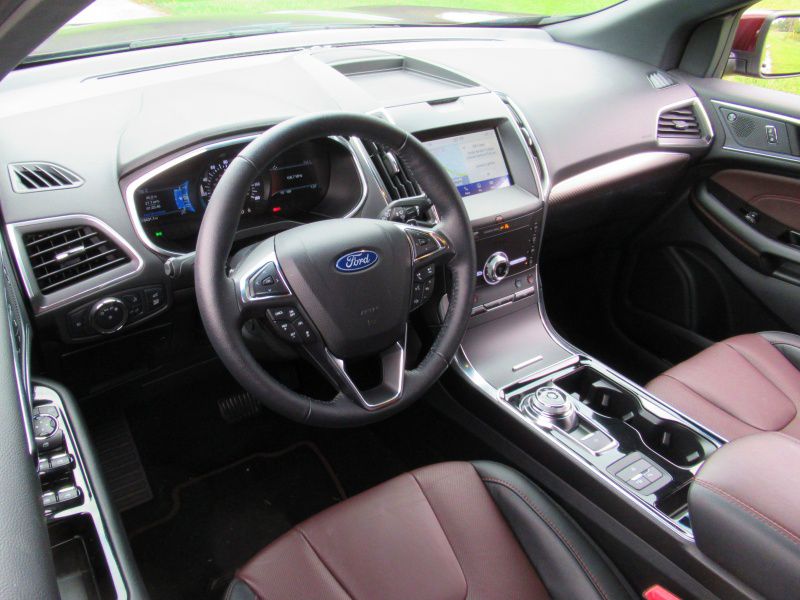
Photo by Brady Holt
Cargo Space
The Atlas Cross Sport’s extra size results in more cargo room than the Edge: 40.3 cubic feet behind the rear seat and 77.8 cubic feet with the rear seat folded flat. The Volkswagen’s more sharply sloped rear windshield cuts into its cargo space behind the rear seat, so the Edge stays close at 39.2 cubic feet. The VW has the clearer advantage in total cargo room, with Ford providing 73.4 cubic feet.
What’s more, the Edge makes up a lot of its lost ground in height rather than floor area. That means the Atlas Cross Sport’s real-world utility is even greater than the specs suggest. Also, the Volkswagen’s rear seat folds perfectly flat, while the Edge’s lies at an incline when folded. If you need to pull more cargo, the Cross Sport can tow up to 5,000 pounds with its optional V6 engine, while both Edge engines top out at 3,500 pounds. However, the base four-cylinder Cross Sport tows just 2,000 pounds.
Volkswagen Atlas Cross Sport
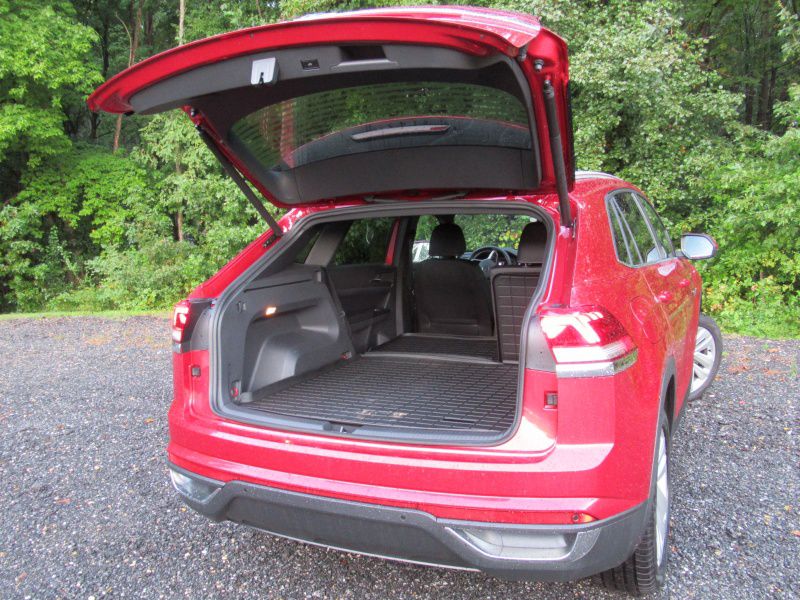
Photo by Brady Holt
Driving Experience
Although the Edge is smaller than the Atlas Cross Sport, it feels like the heavier, more substantial SUV. It’s quieter, too. That’s good news for people who appreciate a big-car feel. However, we’re drawn to the Volkswagen’s more responsive steering and handling, especially considering that neither vehicle has an outstandingly smooth ride.
Under the hood, both vehicles have a standard four-cylinder engine and an optional V6. Ford’s engines have more horsepower in both cases: a 250-horsepower turbo four versus the VW’s 235-hp turbo, and a 335-hp twin-turbo V6 compared with the Atlas’s 276-hp naturally aspirated V6. That said, both four-cylinders feel equivalently eager in the real world. And the Ford’s V6 is limited to a pricy performance model while the Volkswagen’s is widely available in the Atlas Cross Sport lineup.
Volkswagen Atlas Cross Sport
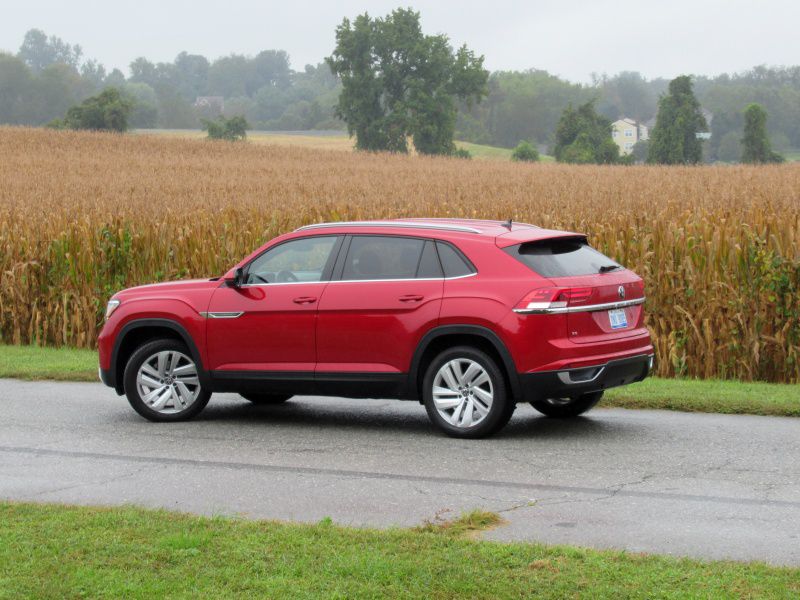
Photo by Brady Holt
Fuel Economy
Despite having more power than the Atlas Cross Sport, the Edge handily beats it for fuel economy. The EPA rates the Edge at 21 mpg in the city, 29 mpg on the highway, and 24 mpg overall with the four-cylinder engine and front-wheel drive, and 21 mpg city, 28 mpg highway, and 23 mpg overall with all-wheel drive. The V6 Edge, sold only with AWD, scores 19 mpg city, 26 mpg highway, and 21 mpg combined.
The Atlas Cross Sport gets 21 mpg city, 24 mpg highway, and 22 mpg combined with the four-cylinder and front-wheel drive, with AWD dropping the estimates to 18 mpg city, 23 mpg highway, and 20 mpg combined. The V6 Atlas Cross Sport scores 17 mpg city, 23 mpg highway, and 19 mpg combined with front-wheel drive and 16 mpg city, 22 mpg highway, and 19 mpg combined with AWD. We tested the Edge and Cross Sport with AWD and four-cylinder engines; both SUVs beat EPA estimates, hitting 28 mpg and 25 mpg, respectively.
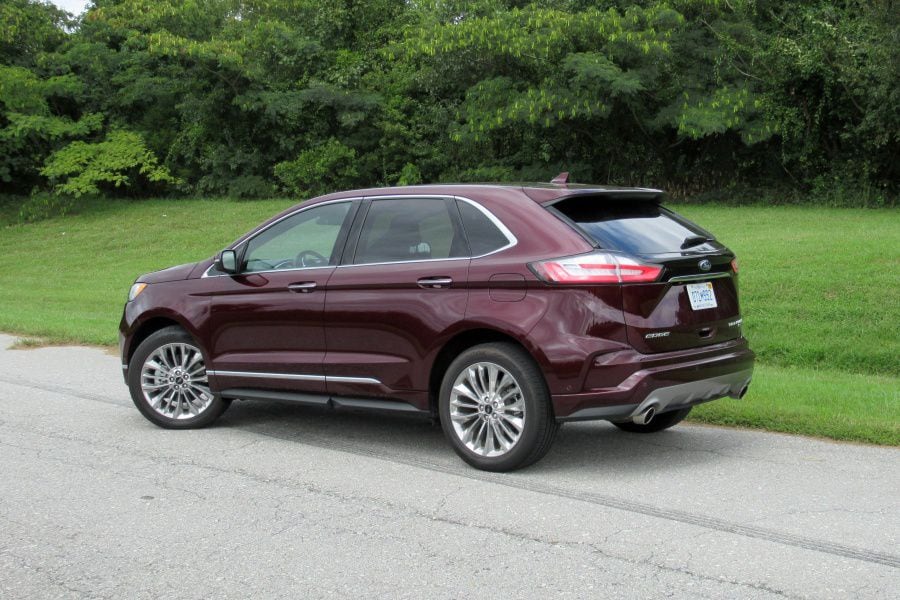
Photo by Brady Holt
Safety
Both the Edge and the Atlas Cross Sport have ample standard safety equipment and excellent crash-test results. The Edge does just a little bit better to win this category.
The Edge is an Insurance Institute for Highway Safety Top Safety Pick, reflecting its crash-test performance and accident-avoidance technology. However, most trim levels earn a low Poor score for headlight performance, though well-optioned models get the second-highest Acceptable score. A wider variety of Atlas Cross Sport trims score the top Good for headlights, and even the cheaper models score Marginal instead of Poor. But the IIHS hasn’t judged the Volkswagen’s automatic emergency braking system, and the Atlas Cross Sport scored four stars instead of the Edge’s five in the National Highway Traffic Safety Administration’s frontal-impact crash test.
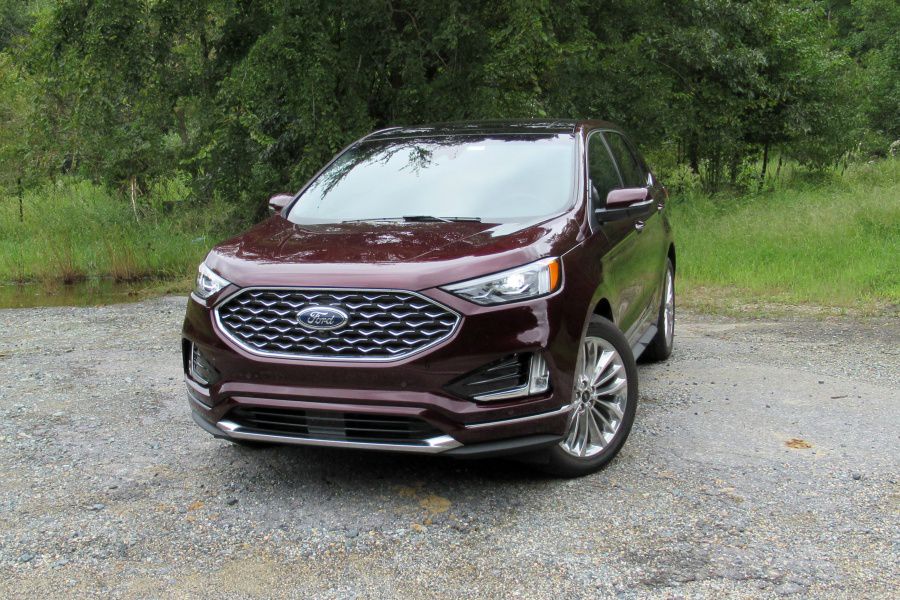
Photo by Brady Holt
Pricing and Features
The 2020 Volkswagen Atlas Cross Sport and 2020 Ford Edge have similar prices and features up and down their respective model lines. The VW starts at $30,545 while the Ford starts at $31,100 with similar standard equipment.
In addition to the slightly lower base price, the Atlas Cross Sport pulls ahead of the Edge because its V6 engine is available on many trim levels (starting from $39,245) while the Edge restricts it to the top ST trim (which starts at $43,625). VW also offers free scheduled maintenance for two years.
Volkswagen Atlas Cross Sport
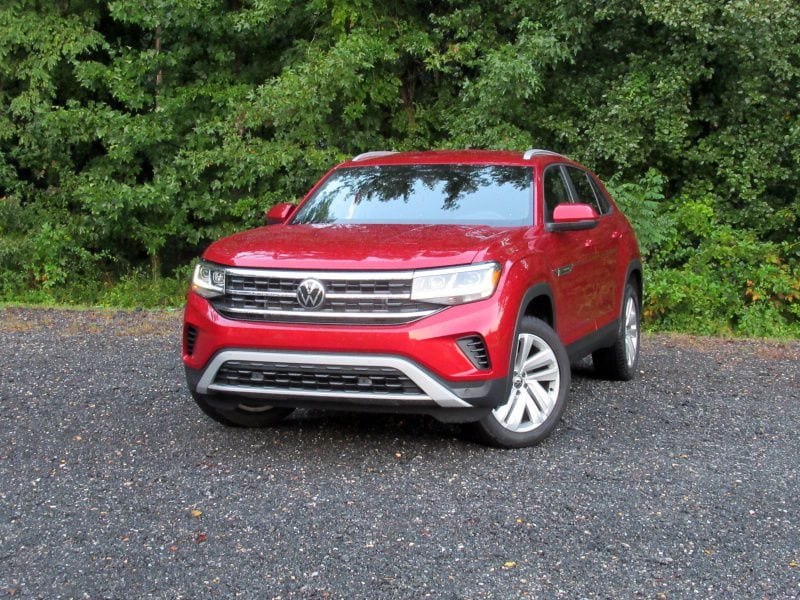
Photo by Brady Holt
Final Thoughts
On a purely practical basis, the 2020 Volkswagen Atlas Cross Sport would be our winner. It’s roomier, it tows more, its controls are easier to use, and it costs less. Its driving dynamics are also more endearing than the Edge’s. But if you were shopping purely on a practical basis, you’d buy the standard Atlas instead of the Cross Sport. For only $1,000 more, it delivers tons more space and bigger windows, along with similar driving dynamics and fuel efficiency. The Cross Sport barely any less bulky than the standard Atlas, either — just not as tall.
So instead, it’s the 2020 Ford Edge that’s our winner. It’s nearly as roomy as the Cross Sport, but with a smaller, more maneuverable footprint. It costs a little more but also gets better gas mileage. Its more comfortable seats, quieter ride, and additional interior design flourishes also help the Edge feel upscale of the Atlas Cross Sport.
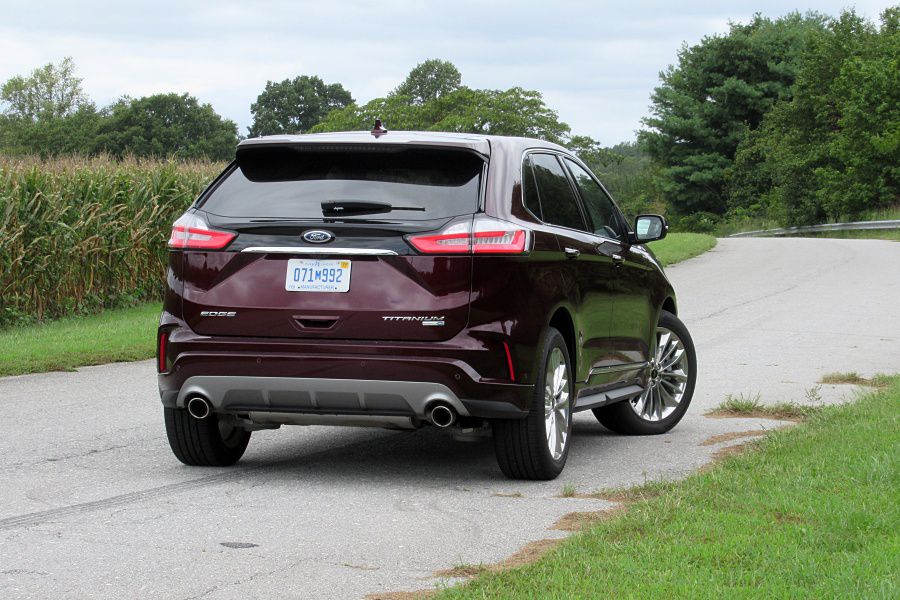
Photo by Brady Holt